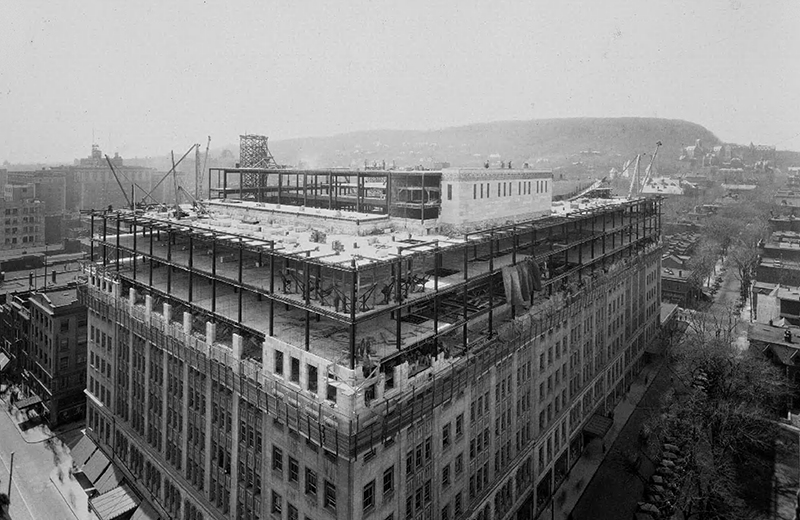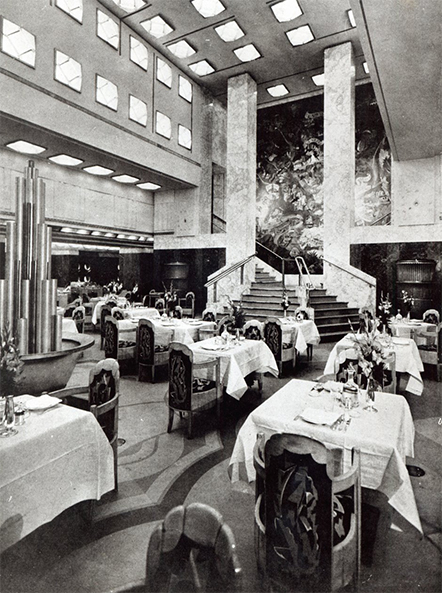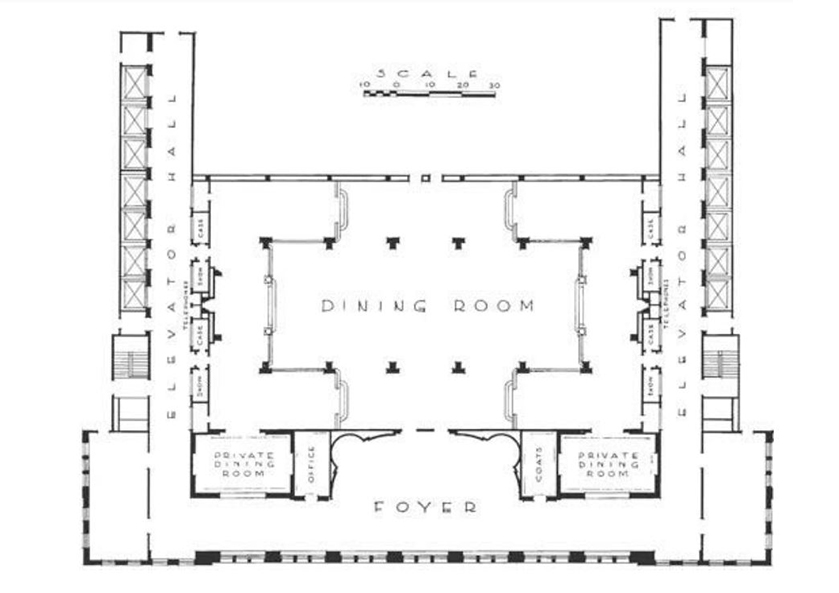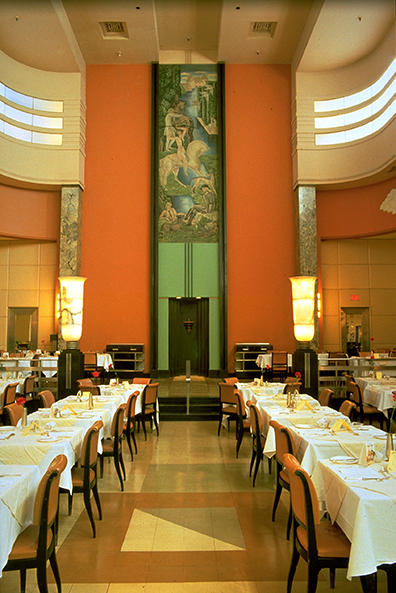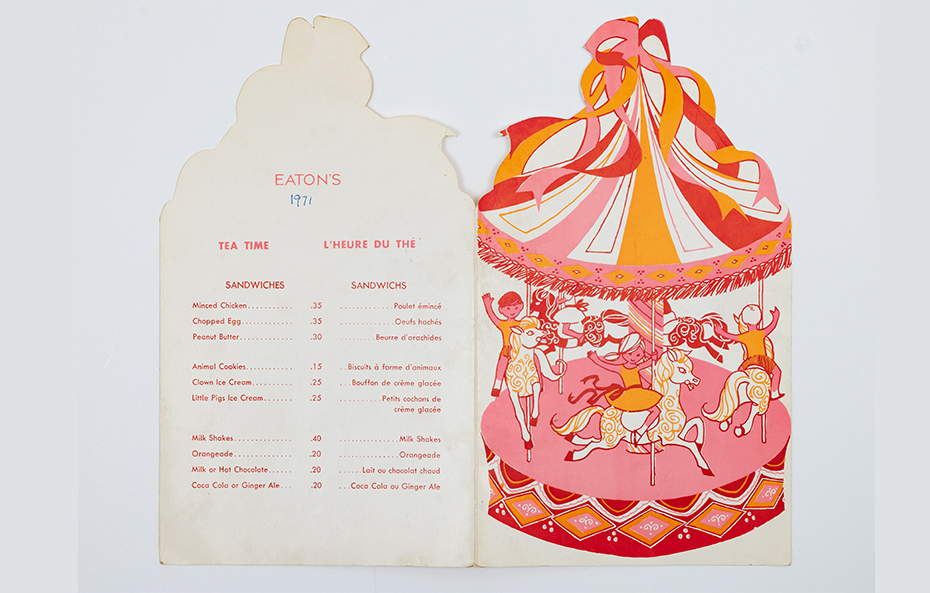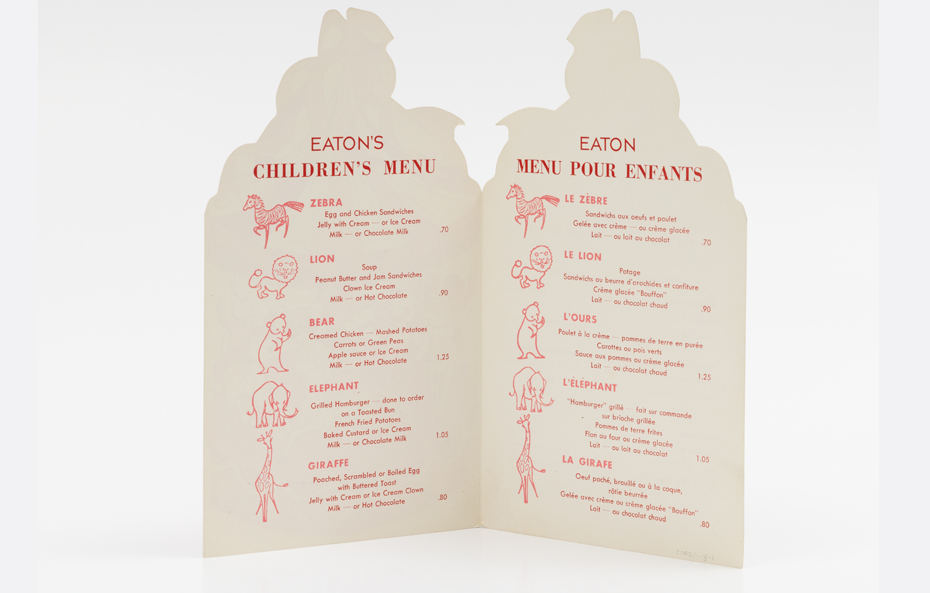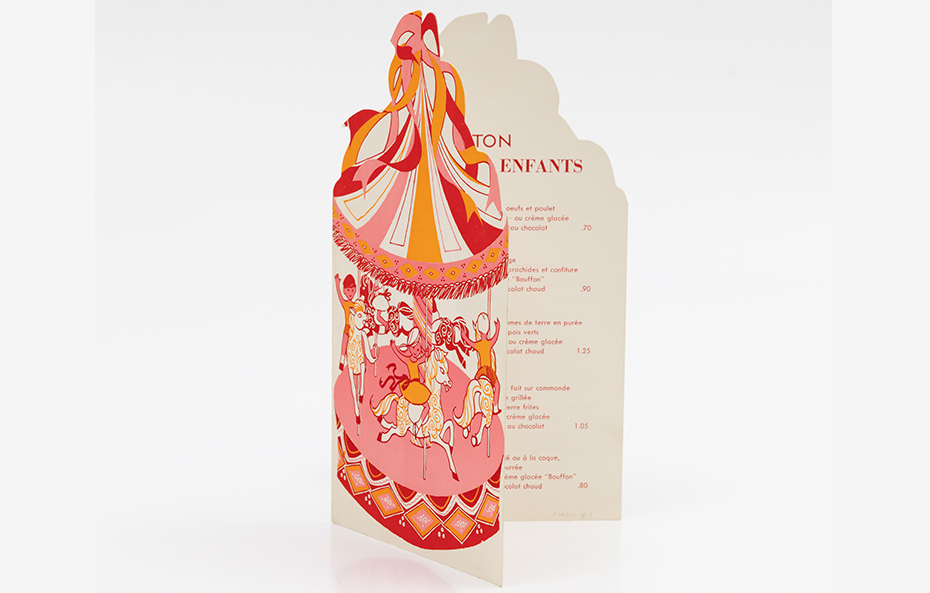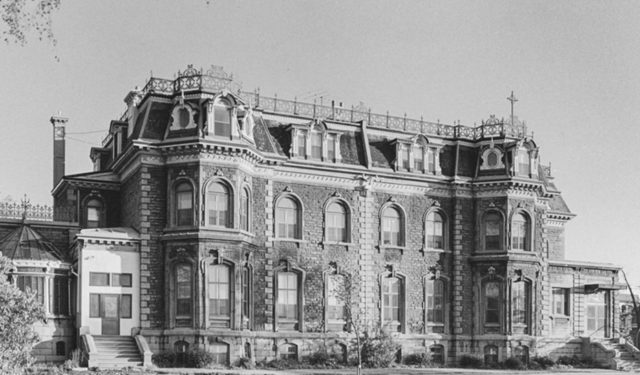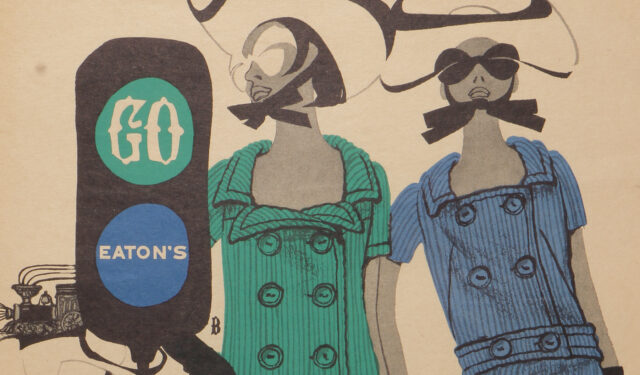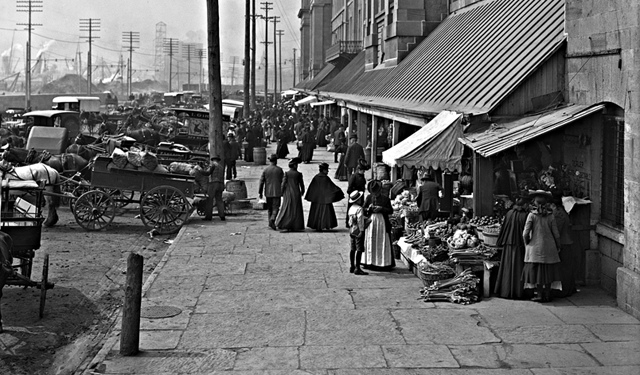Rebirth of Le 9e
Discover or rediscover a jewel of Montreal's architectural heritage. Eaton's iconic restaurant will soon reopen to the public.
April 3, 2024
In collaboration with Héritage Montréal
“It is impossible […] to keep within the bounds of restraint in attempting to describe [the new restaurant’s] magnificence,” ran an Eaton’s newspaper ad in late January 1931. Ninety-three years later, the same excitement is in the air as the iconic dining room is set to reopen after nearly a quarter century of hibernation.
Eaton’s ninth floor restaurant closed its doors on October 14, 1999. For many people, it marked the end of an era and the beginning of a period of uncertainty. Thankfully, however, groups like Heritage Montreal were paying close attention. With Eaton’s bankruptcy looming, the organization convinced Quebec’s Minister of Culture, Agnès Maltais, to take immediate action to classify the department store’s ninth floor restaurant and its exceptional décor—including furniture, cutlery, works of art, lamps, etc.—as a heritage site. Though no one knew whether the restaurant would ever reopen, it was important to save this unique heritage.
“I’m delighted to see this place brought back to life,” says Dinu Bumbaru, Policy Director of Heritage Montreal. “It’s very good news for those with precious memories of the place. At the same time, expectations are running high for everyone else, much like when it opened in 1931.”
But before we head up to the ninth floor, let us take a look at the history of the Eaton’s department store.
The Eaton's business model
Founded in Toronto in 1869 by Irish immigrant Timothy Eaton (1834-1907), the T. Eaton Company was a prime example of the innovative spirit driving the department stores of the era.
With the slogan “Goods Satisfactory or Money Refunded,” Timothy Eaton convinced customers to pay cash instead of using credit, something that had not been done before. In addition to developing extensive advertising campaigns, the store also sold a wide range of its products via catalogue, launching its mail order division in 1884 to reach rural customers.
A typical reformist entrepreneur of the Victorian era, Timothy Eaton was a father figure to his employees. This approach earned him great respect and loyalty from his staff, who were not inclined to unionize.
The founder’s nephew, Robert Young Eaton (1875–1956), succeeded Timothy Eaton and his son John Craig Eaton (1876-1922), taking over the company in 1922. Under his leadership, Eaton’s opened stores throughout Canada: Regina (1926), Saskatoon and Halifax (1928), Edmonton and Calgary (1929).
Montreal: A targeted approach
For its arrival in Montreal, then the metropolis of Canada, Eaton laid the groundwork in two phases, one in 1925-1927, and one in 1930-1931. In phase one, the company purchased the three-storey Goodwin’s department store building at 677 St. Catherine West and, with the help of the Ross & Macdonald architectural firm, undertook a major renovation and added three floors.
The second renovation phase began on January 3, 1930. Not only did Eaton’s build up another three storeys, it decided to revamp its brand image by adopting an extremely modern style for its interiors: Art Deco.
The woman behind the 9th Floor
The woman behind these renovations was none other than John Craig Eaton’s widow, Lady Flora McCrea Eaton (1879-1970). Shortly before her husband’s death in 1922, she joined Eaton’s Board of Directors, where she played a very influential role.
Lady Eaton was an avid traveller and therefore up to date on the latest trends. As a passenger on the 1927 maiden voyage of the Île-de-France transatlantic liner, she had admired the Art Deco décor in the ship’s elegant dining room. This provided the inspiration for the interior design of Eaton’s Montreal and Toronto restaurants built in 1930-1931.
Like a luxury liner
On Lady Eaton’s recommendation (she had met him in Paris), the Montreal architectural firm of Ross & Macdonald hired Jacques Carlu (1890-1976), a professor of architecture and interior design in France and the United States, to design the restaurant.
A graduate of the École des Beaux Arts and recipient of the Prix de Rome (1919), Jacques Carlu was a leading practitioner of Art Deco in North America. Working under Pierre Patout (1879-1965), he had helped design the interiors of the Île-de-France ocean liner (1927). In the United States, he worked on the décor of the Ritz Carlton in Boston and the Stewart & Co. store in New York City in the late 1920s.
According to architectural historian Jean Bélisle, Jacques Carlu never intended the ninth floor to be a replica of the Île-de-France dining room. Using it as inspiration, he wanted to recreate the atmosphere and ambience of travelling on a transatlantic French luxury liner.
All aboard!
The ninth floor restaurant had three sections: two elevator halls, one on either side of the restaurant, the foyer and the architectural showpiece—the main dining room.
Measuring 40 metres wide by 23 metres long with a 10-metre ceiling, this expansive space could accommodate up to 600 guests. Two decorative elements in particular stand out: the large murals by Natacha Carlu and the magnificent white alabaster vases.
Though resolutely modern, the overall effect was very harmonious. The colours, subdued lighting, materials, decorative elements, furniture—no detail was left to chance.
According to Isabelle Gournay, a professor at University of Maryland’s School of Architecture and an expert in the work of Jacques Carlu, the French architect introduced Canada to “an entirely new style and unprecedented degree of sophistication.” In 1931, the impeccably executed design of Le 9e was one of the first examples of the Streamline Moderne (also known as style paquebot) Art Deco style in North America.
Dining at Eaton's
Flavour, quality and comfort were keywords at Eaton’s ninth floor restaurant.
In 1931, the elegant menu featured traditional North American dishes: soup, roast beef, chicken pot pie, breaded fish fillets, cheese (Oka was already on the menu!), coffee, tea and desserts. Comfort food worthy of grandma’s table!
Over time, Eaton’s became a family store, so children were also welcome to the ninth floor. Carefully preserved at the McCord Stewart Museum, this 1971 children’s menu in the shape of a merry-go-round is illustrated with circus animals. Peanut butter and jam sandwiches, creamed chicken with mashed potatoes and green peas, hamburger with fries, hot chocolate, and ice cream: the kitchen obviously knew what its young customers liked to eat!
Also in the 1970s, Saturday mornings in December were reserved for children who could come and eat pancakes with Santa Claus. It was one of many holiday attractions at Eaton’s department stores, which included a ride on the famous Toyville train and the highly anticipated Santa Claus parade along St. Catherine Street, an annual Montreal tradition started by Eaton’s in 1925
A foreseeable bankruptcy
In the 1990s, Eaton’s iconic chain of department stores began a downward spiral. Despite attempts to relaunch, after 130 years of existence, 74 of them in Montreal, Eaton declared bankruptcy on August 20, 1999, triggering the closing of its stores, the laying off of 13,000 employees and the liquidation of its inventory across Canada.
Although the ninth floor restaurant, along with its interior décor and furnishings, was classified a historic monument in 2000 by the Quebec Minister of Culture, heritage conservationists remained vigilant in the years that followed. Heritage Montreal even put Eaton’s ninth floor on its list of Montreal’s top 10 endangered heritage sites.
These public reminders from the organization helped ensure that the iconic restaurant did not disappear from the list of priorities of its owners and public authorities, in addition to highlighting its immense, albeit dormant, potential.
A long-awaited moment!
Finally, in late March 2023, the news came: Ivanhoé Cambridge officially announced the reopening of Le 9e!
Similar to the Round Room on the seventh floor of the former College Street Eaton’s store in Toronto—closed in 1977, designated an historic site, restored and reopened under the name The Carlu in 2003—the ninth floor will house a restaurant, bar and event space.
Under the supervision of professionals from the Quebec Ministère de la Culture, experts have meticulously upgraded, renovated and restored the site using best practices.
This iconic heritage restaurant will once again be accessible after nearly a quarter of a century, to the delight of those who used to go there as well as younger people keen to discover it for the first time.
Acknowledgements
The author and the Museum would like to thank Dinu Bumbaru, Policy Director at Heritage Montreal, and Marie-Maxime de Andrade, PhD candidate in art history at UQAM and Paris 1 Panthéon-Sorbonne, for their invaluable assistance with the writing of this article.
Reférences
Gournay, Isabelle. “Notice biographique de Jacques Carlu” in Archives d’architecture du XXe s. Paris: Ifa/Archives d’architecture du XXe siècle; Liège: Mardaga, 1991.
Lachapelle, Jacques. Le fantasme métropolitain : l’architecture de Ross et Macdonald. Montreal: Presse de l’Université de Montréal, 2001. [https ://books.openedition.org/pum/13932].
Martin, Catherine. Les Dames du 9e/The Ladies of the 9th Floor. Documentary co-produced by the NFB and Galafilm Inc., 1998, 50 min 12 s. [https ://youtu.be/3Z47zN3ct48?si=g7TwYR1E8UCfIi-b].
Soren, Maya. Reclaiming Le 9e: Public Heritage at the Eaton’s Ninth Floor Restaurant, Montréal. Master’s thesis, Concordia University, Montreal, 2011. [https ://spectrum.library.concordia.ca/id/eprint/35952/1/Soren_MA_F2011.pdf].

